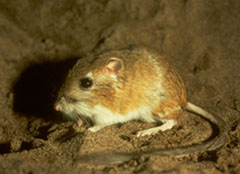Dipodomys ordii
| Ord's kangaroo rat | |
|---|---|
 |
|
| Scientific classification | |
| Kingdom: | Animalia |
| Phylum: | Chordata |
| Class: | Mammalia |
| Subclass: | Eutheria |
| Order: | Rodentia |
| Family: | Heteromyidae |
| Genus: | Dipodomys |
| Species: | D. ordii |
| Binomial name | |
|
Dipodomys ordii Woodhouse, 1853 |
|
Ord's kangaroo rat (Dipodomys ordii) is a kangaroo rat native to western North America, specifically the Great Plains and the Great Basin, with its range extending from extreme southern Canada to central Mexico.
Ord's kangaroo rat has a fifth toe on its hind feet, which distinguishes it from Dipodomys elator. It is bicolored with gold-brown dorsal hair and a white stomach. It has a long tail with a bushy tip, and is dark dorsally and ventrally with a white lateral stripe. Its hind feet are modified for jumping, and exceed 35 mm in length, and its total length exceeds 240 mm. Its tail is usually less than 160 mm, distinguishing it from D. elator (which exceeds 160 mm).
Though a common species in the United States, the population in Canada is considered endangered.
The currently accepted scientific name for Ord's kangaroo rat is Dipodomys ordii Woodhouse. It belongs to the family Heteromyidae, kangaroo rats and mice. Hall listed 35 subspecies, but Kennedy and Schnell reported many of these subspecies are probably not legitimate since they were based on the assumption of little sexual dimorphism in the species. It has now been established that sexual dimorphism within the taxon is considerable.
Ord's kangaroo rat ranges from southern Alberta and southern Saskatchewan to southern Hidalgo, Mexico, and from central Oregon and eastern California east to central Kansas and Oklahoma.
Ord's kangaroo rats occur mainly in semiarid, open habitats. In Nevada, they were trapped in desert scrub and gravelly soil, flat pebble desert, and washes. In Utah, Ord's kangaroo rats have an affinity for open shrublands and grasslands on sandy soils. In southeastern Idaho, big sagebrush/crested wheatgrass (Agropyron cristatum) range, most Ord's kangaroo rat captures occurred on disturbed sites or areas of sparse cover: Russian thistle (Salsola kali), cheatgrass (Bromus tectorum), and green rabbitbrush (Chrysothamnus viscidiflorus), followed by disturbed areas seeded to crested wheatgrass, then undisturbed big sagebrush. In western South Dakota, Ord's kangaroo rats are associated with black-tailed prairie dog (Cynomys ludovicianus) towns. In Wyoming, Ord's kangaroo rats are abundant in sand dune communities where vegetation is greater than 10 inches (25 cm) tall and bare soil exceeds 40%. In Colorado, Ord's kangaroo rats were primarily captured in open areas with firm soil. Firm or lightly compacted soils are needed for burrow construction; highly compacted soils are too hard for them to dig. In areas of desert pavement or tough clay soils in the Trans-Pecos region of Texas, Ord's kangaroo rats are confined to pockets of windblown sand and alluvial soils along arroyos.
...
Wikipedia

